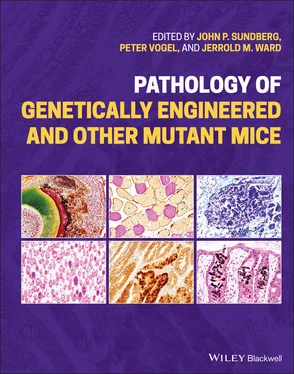Pathology of Genetically Engineered and Other Mutant Mice
Здесь есть возможность читать онлайн «Pathology of Genetically Engineered and Other Mutant Mice» — ознакомительный отрывок электронной книги совершенно бесплатно, а после прочтения отрывка купить полную версию. В некоторых случаях можно слушать аудио, скачать через торрент в формате fb2 и присутствует краткое содержание. Жанр: unrecognised, на английском языке. Описание произведения, (предисловие) а так же отзывы посетителей доступны на портале библиотеки ЛибКат.
- Название:Pathology of Genetically Engineered and Other Mutant Mice
- Автор:
- Жанр:
- Год:неизвестен
- ISBN:нет данных
- Рейтинг книги:3 / 5. Голосов: 1
-
Избранное:Добавить в избранное
- Отзывы:
-
Ваша оценка:
- 60
- 1
- 2
- 3
- 4
- 5
Pathology of Genetically Engineered and Other Mutant Mice: краткое содержание, описание и аннотация
Предлагаем к чтению аннотацию, описание, краткое содержание или предисловие (зависит от того, что написал сам автор книги «Pathology of Genetically Engineered and Other Mutant Mice»). Если вы не нашли необходимую информацию о книге — напишите в комментариях, мы постараемся отыскать её.
An updated and comprehensive reference to pathology in every organ system in genetically modified mice Pathology of Genetically Engineered and Other Mutant Mice
Pathology of Genetically Engineered and Other Mutant Mice
Pathology of Genetically Engineered and Other Mutant Mice — читать онлайн ознакомительный отрывок
Ниже представлен текст книги, разбитый по страницам. Система сохранения места последней прочитанной страницы, позволяет с удобством читать онлайн бесплатно книгу «Pathology of Genetically Engineered and Other Mutant Mice», без необходимости каждый раз заново искать на чём Вы остановились. Поставьте закладку, и сможете в любой момент перейти на страницу, на которой закончили чтение.
Интервал:
Закладка:
70 70 Harding, S.D., Armit, C., Armstrong, J. et al. (2011). The GUDMAP database – an online resource for genitourinary research. Development 138 (13): 2845–2853.
71 71 Lein, E.S., Hawrylycz, M.J., Ao, N. et al. (2007). Genome‐wide atlas of gene expression in the adult mouse brain. Nature 445 (7124): 168–176.
72 72 Krishnan, A., Samtani, R., Dhanantwari, P. et al. (2014). A detailed comparison of mouse and human cardiac development. Pediatr. Res. 76 (6): 500–507.
73 73 Talman, V., Teppo, J., Poho, P. et al. (2018). Molecular atlas of postnatal mouse heart development. J. Am. Heart Assoc. 7 (20): e010378.
74 74 Amberger, J.S., Bocchini, C.A., Schiettecatte, F. et al. (2015). OMIM.org: Online Mendelian Inheritance in Man (OMIM(R)), an online catalog of human genes and genetic disorders. Nucleic Acids Res. 43 (Database issue): D789–D798.
75 75 McKusick, V.A. (2007). Mendelian Inheritance in Man and its online version, OMIM. Am. J. Hum. Genet. 80 (4): 588–604.
76 76 Armit, C., Richardson, L., Venkataraman, S. et al. (2017). eMouseAtlas: an atlas‐based resource for understanding mammalian embryogenesis. Dev. Biol. 423 (1): 1–11.
77 77 Armit, C., Richardson, L., Hill, B. et al. (2015). eMouseAtlas informatics: embryo atlas and gene expression database. Mamm. Genome 26 (9–10): 431–440.
78 78 Richardson, L., Graham, L., Moss, J. et al. (2015). Developing the eHistology Atlas. Database 2015: bav105.
79 79 Graham, E., Moss, J., Burton, N. et al. (2015). The atlas of mouse development eHistology resource. Development 142 (14): 2545.
80 80 Stevenson, P., Richardson, L., Venkataraman, S. et al. (2011). The BioMart interface to the eMouseAtlas gene expression database EMAGE. Database 2011: bar029.
81 81 Armit, C., Venkataraman, S., Richardson, L. et al. (2012). eMouseAtlas, EMAGE, and the spatial dimension of the transcriptome. Mamm. Genome 23 (9–10): 514–524.
82 82 Kaufman, M.H. (1992). The Atlas of Mouse Development. London: Academic Press.
3 Mouse Genetic Nomenclature: The Underpinning of Mouse Genetics
John P. Sundberg, Dale A. Begley, Melissa L. Berry, Michelle N. Perry, David Shaw, and Paul N. Schofield
Introduction
Pathologists are meticulous about the accurate use of nomenclature when making a diagnosis, even though there are often numerous synonyms for the disease under investigation. Debates about the specificity of diagnostic terms and the consequences, particularly for genetics, of differences in nosological preferences, can be critical in coming to an understanding of disease etiology and prognosis. For example, differences in “lumping” and “splitting” diagnoses [1] can make the difference between discovering and missing a Genome Wide Association Study (GWAS) signal [2]. In spite of this, few pathologists and researchers are as careful about the accurate use of mouse genetic nomenclature, yet this is as important to the description of a novel mouse model for a human disease as the pathologic description of the lesions.
Systematic genetic nomenclature expresses, in a succinct and precise way, the background of the strain under investigation, the presence of complex sequence variants of many types, and the genetic relationship of one strain to another. Understanding the fundamentals of genetic terminology is a key skill needed to design and interpret experiments using laboratory mice, and a critical part of reporting and sharing results and resources. This has a huge impact on reproducibility as well as accuracy of interpretation, and is a very important part of making data FAIR ( https://en.wikipedia.org/wiki/FAIR_data) as it uses community agreed norms for the exchange and interpretation of information [3].
This chapter provides an overview of the various types of mouse strains (inbred, recombinant inbred, congenic, consomic, hybrid, and others [ Table 3.1]), outbred stocks, and mutations (spontaneous or engineered) and how their symbols reflect what they are and how they were made. Methods for creating genetically engineered mice are numerous and rapidly changing [4], so they will not be covered here other than in providing information on the currently used genetic designations for the mice created.
Why Use Standardized Nomenclature?
Even before the days of easy access to computers and search algorithms, words were created to reflect specific things. In medicine, for example Latin was adopted in Europe as a language commonly understood in many countries with their own languages and with defined, agreed meanings – a lingua franca . In so doing, clinicians could communicate reliably with each other through time and across locations. The same is true for mouse genetic nomenclature ( Table 3.2). This has become more important when exchanging and aggregating information between international databases to access, analyze, and distribute data. Searches can only be accurately completed when words, or gene and protein symbols, are written correctly and have semantic consistency. Some databases, such as that of the Sanger Mouse Genomes Project ( http://www.sanger.ac.uk/sanger/Mouse_SnpViewer), will only work if the correct current gene symbol is entered. If your search returns “The gene you selected is not in the database,” it may mean that you entered the wrong symbol or the name/symbol has been changed and is no longer in use. For example, if you search for p53 in this database, it returns the response above as the correct current term is Trp53 ( Figure 3.1).
The Mouse Genome Informatics Database (MGI, www.informatics.jax.org), fortunately, associates synonyms, the unofficial symbols used in publications, with their official nomenclature. Therefore, a search for the commonly used symbol for the gene mutated in publications can be used to find the currently used correct gene and allele symbol. Figure 3.2illustrates how this can be used to identify the correct allele for Cdx2 in a paper.
International committees were organized to standardize genetic nomenclature for rodents ( http://www.informatics.jax.org/mgihome/nomen/short_gene.shtml), humans ( https://www.genenames.org/about/guidelines/#!/#tocAnchor‐1‐29), and other species. The MGI database provides detailed information on this subject for mice ( http://www.informatics.jax.org/mgihome/nomen/index.shtml) and The Jackson Laboratory also offers a quick guide to nomenclature ( https://www.jax.org/jax‐mice‐and‐services/customer‐support/technical‐support/genetics‐and‐nomenclature). This system has been in use and evolving for over 80 years [5]. One goal of these committees is to provide concise, precise, and unique gene symbols and names ( Figure 3.3). Mouse genetic nomenclature continues to evolve to accommodate the ever‐increasing complexity of functional genomics as well as the genetically engineered mice created, reflecting the biotechnology that made these advances possible.
Table 3.1 Types of mouse strains.
| Inbred mice : 20 generations of brother X sister matings using mice of disparate or even unknown backgrounds |
| F1 hybrid mice : Progeny of two inbred strains |
| F2 hybrid mice : Progeny of a female and male of the same F1 hybrid lineage |
| Recombinant inbred (RI) mice : 20 generations of brother X sister matings from parents of different inbred strains |
| Recombinant congenic mice : Two inbred strains are crossed followed by several backcrosses to one of the parental strains. The resulting mice are then inbred without selection |
| Collaborative Cross (CC) mice : Modified RI lines using parents from 8 genetically diverse inbred strains |
| Congenic mice : Moving a defined genetic interval from one inbred strain to another inbred strain |
| Consomic mice : A strain in which one intact chromosome from the donor strain is transferred to a host strain (one line is created for each chromosome) |
| Conplastic mice : Backcrossing the nuclear genome from one inbred strain into the cytoplasm of another inbred strain (mitochondrial parent is always the female parent during the backcross) |
Table 3.2 Standardized nomenclature.
Читать дальшеИнтервал:
Закладка:
Похожие книги на «Pathology of Genetically Engineered and Other Mutant Mice»
Представляем Вашему вниманию похожие книги на «Pathology of Genetically Engineered and Other Mutant Mice» списком для выбора. Мы отобрали схожую по названию и смыслу литературу в надежде предоставить читателям больше вариантов отыскать новые, интересные, ещё непрочитанные произведения.
Обсуждение, отзывы о книге «Pathology of Genetically Engineered and Other Mutant Mice» и просто собственные мнения читателей. Оставьте ваши комментарии, напишите, что Вы думаете о произведении, его смысле или главных героях. Укажите что конкретно понравилось, а что нет, и почему Вы так считаете.












